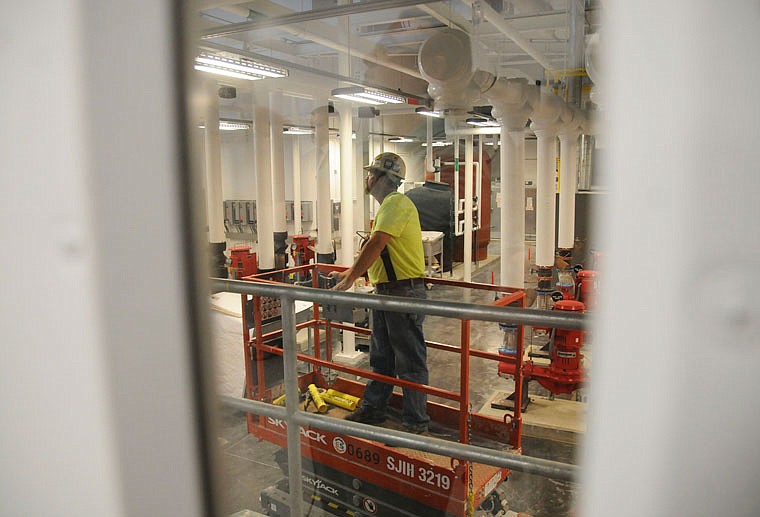The first phase of the new Fulton State Hospital construction has been completed, state officials announced Thursday.
Gov. Jay Nixon, along with Mental Health and Office of Administration officials, toured the 65,000-square-foot Energy Control Center, which will house dietary services, the communication center, materials management and computer information. River City Construction built the facility for $23.1 million.
With its completion, construction crews will begin building the main hospital, starting with the administration building located at the end of 5th Street in Fulton. Eventually, it will be attached to the ECC, allowing direct access to patients.
Standing in the kitchen of the new facility, Nixon said the building is a sign of what's to come for the new Fulton State Hospital.
The main hospital, designed as four pod systems, will hold 300 beds for patients in the maximum-security Biggs and the intermediate-security Guhleman forensic centers.
The Legislature approved the $211 million project in 2014, following increasing political pressure and safety concerns.
When he called for a new mental health facility in his 2013 State of the State address, Nixon said some were skeptical, but "projects like this transcend the day-to-day politics."
"If the past had been precedent, this project may have fallen by the wayside yet again," he said. "But, we didn't give up, and the people of Fulton didn't give up."
Built in 1851, the Fulton State Hospital is the oldest psychiatric facility west of the Mississippi River. Its decrepit state has caused poor conditions for employees.
Improved working conditions
Dietary service employees work in a building without air conditioning, said Kristen Crews, director of food services.
"(The new building) should improve everything," Crews said. "They're going to have air conditioning - that's huge. They don't have air conditioning now, so they work in, maybe, 110 degrees in the dishroom. Then, they're standing over cooking. And it's bad already, and they're making more heat."
When old equipment falls apart, the parts needed are no longer made. Cooks use a large mixer decommissioned from a Korean War-era warship. The new kitchen is fully equipped with new appliances.
"They will no longer have to use food service equipment that was bought secondhand before I was born," said Dr. Bob Reintz, Fulton State Hospital CEO, who turned 60 on Thursday. "They no longer have to worry about freezer doors crumbling from age that fall off the hinges. Our staff will no longer have to work in a brick and mortar building that once held African American patients who were segregated from other patients."
Dietary service employees start training next week before moving into the ECC in mid-July. The current dietary services building will be demolished.
To date, 12 buildings have been demolished. The second phase of demolition will tear down eight more.
"Looking forward, we've designed for future flexibility at this site as well as the new hospital," said Cathy Brown, facilities management director with the Office of Administration.
The ECC has energy-saving features, including solar panels, high-efficiency heating and air conditioning, and motion and daylight sensing lighting. Two generators stored in the ECC can backup the entire mental health facility. The state is paying the city of Fulton $1.1 million for new electric, water and gas lines, said Darrell Dunlap, Fulton utility superintendent.
Safety measures at forefront
Staff and patients consulted with architectural firm Parsons Brinckerhoff on the new Fulton State Hospital design in town hall meetings, said Anthony Menditto, director of treatment services and acting chief operations officer.
"Staff that are out there every day, working with patients and giving them treatment, think of things that some of us who are little bit further removed may not," he said. "So, it's really important to listen carefully to what they have to say, and we made sure we did that."
As the most dangerous work place in the state, FSH worker's compensation costs totaled to $4 million last year. The state also paid $5.3 million in overtime costs in the past fiscal year, according to the Department of Mental Health.
With more than 1,150 full-time employees, about 950 interact with patients daily. The turnover rate for nurses is 43 percent.
Internal design includes clear sight lines and high ceilings. The new hospital will have larger common areas so patients can share a space without feeling crowded. Dining areas will also be attached to individual wards.
"When you have that many patients in a space like that, it increases the risk of something happening," Reintz said. "In the new building design, people are actually going to be living and eating in the same area."
While the new hospital is designed to increase safety, it won't solve all the issues. In preparation for moving into the new hospital, Reintz said staff will re-address training on how to handle aggressive patients.
The expected completion date is spring 2019.
Correction: River City Construction built the Energy Control Center at the Fulton State Hospital. The original version of this article incorrectly stated it was Three Rivers Construction.

